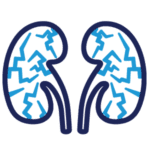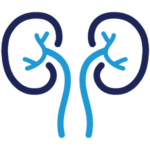Alnylam Pharmaceuticals is responsible for the funding and content of this website. The site is intended for Healthcare Professionals in Europe, Middle East and Africa. For disease awareness purposes only.
Alnylam Pharmaceuticals is responsible for the funding and content of this website. The site is intended for Healthcare Professionals in Europe, Middle East and Africa. For disease awareness purposes only.
PH1 is a heterogeneous disease.1,4 PH1 patients with identical genotypes, and even members of the same family, can have variable disease symptoms.4
Infant and child patients may present with one or more of the clinical manifestations below:1,4–7



















Patients may present with one or more of the clinical manifestations below:1,4–7
















Kidney stones are the most common clinical manifestation and the one that most often leads to a diagnosis of PH1, though not all patients with PH1 may be stone formers.5,8,9 All patients suspected to have PH1 should undergo genetic assessment according to the ERKNet and OxalEurope guidelines 2023.10
Though the course of PH1 is well characterised, with patients typically advancing toward ESKD, the rate of progression is variable.1,5,13 In some instances, kidney function can decline after a single incident of dehydration due to acute illness or intense physical activity.11,12,14-16 This can occur even in patients with previously stable disease.14
Diagnose as soon as possible to ensure prompt management.1,2,3,6,19,20
ERKNet and OxalEurope guidelines 2023 recommend that all patients with suspected PH1 undergo genetic testing10


Becky
UK mother of two children with PH1
References: 1. Milliner DS, Harris PC, Cogal AG, Lieske JC. https://www.ncbi.nlm.nih.gov/books/NBK1283/. Updated February 10, 2022. Accessed October 2023. 2. Ben-Shalom E, Frishberg Y. Pediatr Nephrol. 2015;30(10):1781–1791. 3. Cochat P, Hulton SA, Acquaviva C, et al. Nephrol Dial Transplant. 2012;27(5):1729–1736. 4. Hoppe B. Nat Rev Nephrol. 2012;8(8):467–475. 5. Hoppe B, Beck BB, Milliner DS. Kidney Int. 2009;75(12):1264–1271. 6. Cochat P, Rumsby G. N Engl J Med. 2013;369(7):649–658. 7. Hopp K, Cogal AG, Bergstralh EJ, et al. J Am Soc Nephrol. 2015;26:2559–2570. 8. Edvardsson VO, Goldfarb DS, Lieske JC, et al. Pediatr Nephrol. 2013;28(10):1923–1942. 9. Hoppe B, Langman CB. Pediatr Nephrol. 2003;18:986–991. 10. Groothoff JW, Metry E, Deesker L, et al. Nat Rev Nephrol. 2023;19(3):194–211. 11. Cochat P. Kidney Int. 1999;55(6):2533–2547. 12. Leumann E, Hoppe B. J Am Soc Nephrol. 2001;12(9):1986–1993. 13. Jamieson NV. Am J Nephrol. 2005;25(3):282–289. 14. El-Reshaid K, Al-Bader D, Madda JP. Saudi J Kidney Dis Transpl. 2016;27(3):606–609. 15. Harambat J, Fargue S, Bacchetta J, Acquaviva C, Cochat P. Int J Nephrol. 2011;2011:864580. 16. Tintillier M, Pochet JM, Cosyns JP, Delgrange E, Donckier J. Clin Nephrol. 2004;62(2):155–157. 17. Falk N, Castillo B, Gupta A, McKelvy B, Bhattacharjee M, Papasozomenos S. Ann Clin Lab Sci. 2013;43(3):328–331. 18. Lorenz EC, Michet CJ, Milliner DS, Lieske JC. Curr Rheumatol Rep. 2013;15(7):340. 19. van Woerden CS, Groothoff JW, Wanders RJA, Davin JC, Wijburg FA. Nephrol Dial Transplant. 2003;18(2):273–279. 20. Raju DL, Cantarovich M, Brisson ML, Tchervenkov J, Lipman ML. Am J Kidney Dis. 2008;51(1):e1–e5. 21. Ferraro PM, D’Addessi A, Gambaro G. Nephrol Dial Transplant. 2013;28(4):811–820. 22. Hoppe B, Kemper MJ. Pediatr Nephrol. 2010;25(3):403–413.
PH1-CEMEA-00127 | November 2023


ThinkPH1 is a trademark of Alnylam Pharmaceuticals, Inc.
©2023 Developed and produced by Alnylam Switzerland GmbH. All rights reserved.
PH1-CEMEA-00124
November 2023
Alnylam Pharmaceuticals is responsible for the funding and content of this website. The site is intended for Healthcare Professionals in Europe, Middle East and Africa. For disease awareness purposes only.